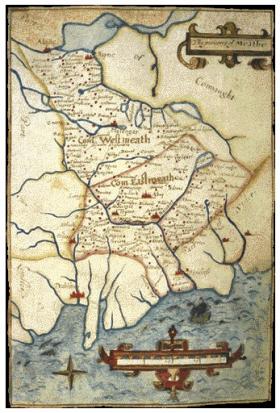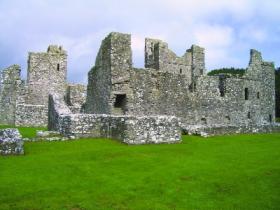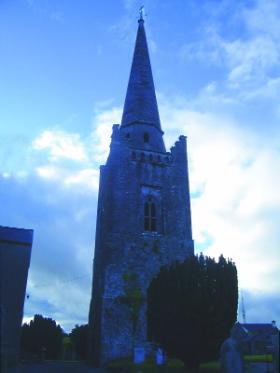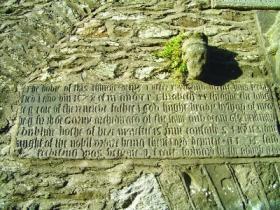A typical clergyman? Richard Plunkett and the Reformation in Tudor Meath
Published in Early Modern History (1500–1700), Features, Issue 6 (Nov/Dec 2005), Volume 13
A 1587 map of Meath. (Trinity College, Dublin)
Sixteenth-century clergy in Ireland were, for the most part, singularly ill-equipped to preach and spread religious reform throughout the country, and Meath was not exempt from this general malaise. The clergy in the diocese of Meath lacked discipline and were not highly regarded, particularly by the Protestant authorities of the time. Hugh Brady, an Elizabethan bishop there, despaired of his ‘ragged clergie’, who were both ‘stuborne and ignorantlie blinde’. With this ineffectual clergy, Brady doubted whether he would ever win over the ‘symple multitude’, as religious reform could hardly be successfully implemented in benefices that possessed no reliable cleric.
Many of the local clergy seem to have been poorly educated. In the fifteenth century a theologian was employed in the archdiocese of Armagh (of which Meath was a part), and a seminary was maintained in the town to educate the clergy there. It was not feasible, however, to expect budding clergy from Meath, many of whom would have been desperately poor, to attend school in Armagh, as the costs incurred through such a move would have been prohibitive. There are only records of two schools operating in the diocese of Meath in the early sixteenth century, one at the nunnery of Odder, which was closed in 1539 as part of the dissolutions, and one in Donsoghly, which was run from the ‘priest’s chamber’. There were no other schools in the diocese capable of satisfactorily teaching those who aspired to the priesthood. A school founded by Hugh Brady in the 1560s was later shut down owing to the lack of suitable premises, and attempts to have another one erected under the direct patronage of Queen Elizabeth ended in failure. The lack of a university in Ireland before 1592 only exacerbated this situation. The result was that many of the clergy in Meath received only the most cursory of educations before embarking on their vocation.
Richard Plunkett
Although evidence relating to clergy in Tudor Ireland is scarce, there is a vast amount of information in the state papers about one particular minister in late Elizabethan Meath. This permits us to undertake a case-study of a cleric who personifies all of the various transgressions of the clergy in sixteenth-century Ireland. Richard Plunkett was parson of Kilskeer in the diocese of Meath from 1573 until his removal in 1581. He serves as an interesting example of clerical corruption as the canonical and civil offences that he committed and was punished for—including simony, plurality, absenteeism, adultery, assault, praemunire and recusancy—were recorded and make for engrossing reading. Although other clergymen were often guilty of at least some of these same misdemeanours, they often avoided censure for their misdeeds. Judging by the amount of paperwork relating to Plunkett, however, it seems that his case was a notorious one. It is possible, therefore, that he had alienated his support in the area as a result of some of his more outrageous transgressions. Furthermore, it seems that Plunkett had also attracted the attention of the authorities owing to his public support for the pope when state awareness of recusancy was on the rise.
Pluralism and absenteeism

The priory of Fore, Co. Westmeath. William Nugent, who had been prior of the abbey at the time of dissolution in the late 1530s, was guilty of pluralism: in 1546 he was both vicar of Ardnurghry and rector of Trim. (Tara McGovern)
Plunkett held not only the parsonage of Kilskeer but also the vicarages of Girley and Ardmulchan, as well as the archdeaconry of Armagh—an abuse known as pluralism. Combined, these positions must have made him an important and influential figure in the diocese. Pluralism was a prevalent abuse in sixteenth-century Meath. The bishop of Meath in the 1520s, Richard Wilson, allegedly caused numerous spiritual and temporal problems in his diocese as a result of his absenteeism. In 1560 Adam Loftus, later archbishop of Armagh and Dublin but then a chaplain based in Dublin, was rector of Paineston in Meath despite rarely, if ever, venturing out to his benefice. William Nugent, who had been prior of the abbey of Fore at the time of dissolution, was vicar of Ardnurghry as well as rector of Trim in 1546. When Cornelius Cahan was given a licence of absence from his benefice in Athlumney in 1549 he was also the bishop of Ardagh, where he spent most of his time. Terence O’Carolan was rector of Knock from 1530 to 1550 as well as holding the position of rector in Roneth in 1539.
Pluralism was also closely linked to absenteeism; if an incumbent held more than one living, it is obvious that he could not be resident in all of them simultaneously, which meant that, for at least part of the time, one or more of these benefices had no resident minister. This problem was occasionally solved through the appointment of a stipendiary curate to assist in the running of the benefice, though not every benefice-holder provided one. Although many others before and since had held more than one benefice, it was admitted by Plunkett that he occupied these livings without the required ecclesiastical dispensations; nor does he seem to have provided a curate to perform his duties in his absence.
Simony and advowsons
Plunkett was accused by two witnesses of selling spiritualities, a practice known as simony. It was also claimed that the parson gave £200 to a gentleman named Thomas Buen for the ‘p[re]sentation of the p[ar]sonage of Armolghan and the tythes of the vicarage of Kylskyer duringe his life to Sr Oliver Plunkett Knight’. Many bishops also indulged in the practice of alienating church property, or episcopal temporalities, as a means of supplementing their income. Episcopal temporalities were parcels of landed properties and dwellings that could be used to generate income for the running of the diocese. With these parcels of property often came the right of presentation to benefices, known as advowsons. The patron of a living had the right to present his candidate to the benefice in his care. By the later sixteenth century recusant patrons regularly presented family members and associates who were often conservative clergy with neither the capability nor inclination to introduce religious reform into livings in their care.
The advowson for the vicarage of Kilskeer was held by the recusant Plunkett family in the early seventeenth century, and it is likely that Richard was related to the person who presented him to the benefice in the 1570s. The advowson for the vicarage of Girley was held by the baron of Slane, another known recusant. It is also possible that these patrons would have appointed conformist reading ministers to benefices in their gift at little cost and diverted the remainder of the funds to support recusant priests. When surveying the diocese of Meath, Hugh Brady discovered that 105 rectories were leased out to farmers with ‘no parson or vicar resydent upon any of them, and a verie simple, or sorry curate, for the most part, appoynted to serve them, amoung which number of curates, only xviii were found able to speak Englishe; the rest Irishe priests, or rather Irishe rogues, having verie little Latin, less learning and civilitie’. Indeed, one tithe-farmer in Elizabethan Meath who had appropriated sixteen benefices had not provided suitable clergy for any of them, much to the dismay of government officials. As religious institutions held many advowsons in Meath, the monastic dissolutions in the 1530s meant that many of these advowsons were now in the hands of the secular community, which later played a significant role in the failure of the Reformation in the diocese.
The emergence of recusancy

The bell-tower in Kells, Co. Meath, rebuilt and rededicated by Bishop Hugh Brady of Meath, at a time when Plunkett held his living in Girley, just outside Kells. Brady, one of Plunkett’s accusers, despaired of his ‘ragged clergie’, who were both ‘stuborne and ignorantlie blinde’. (Tara McGovern)
In addition, Plunkett was found guilty of ‘allowing, and celebretinge of masses, and all other kind of Romysh ceremonies in his churches’, and of praying for the pope during these celebrations. The teachings of the Counter-reformation were beginning to infiltrate into conservative families in the Pale. Apparently imbued with the post-Tridentine spirit, Plunkett claimed that the pope was the true head of the church and damned as heretics those who followed the queen’s religious settlement. At a time of heightened prejudice towards recusants this was possibly the most dangerous practice to be accused of, and it is interesting to note that Plunkett never admitted to this charge, despite confessing to a number of his other misdemeanours.
Plunkett’s public displays of hostility towards reformed religion were especially disturbing for those attempting to implement the reforms, as it was reported that he had persuaded many people of the validity of his claims. He was also suspected of involvement in the rebellions and conspiracies that were taking place in Leinster in the early 1580s, such as those led by Viscount Baltinglass and William Nugent. Like many others, Plunkett himself had initially carried out the queen’s wishes and conformed to her religious reforms, before displaying a change of heart to receive the pope’s absolution. It is likely that Plunkett, like many others, had publicly celebrated the Protestant service while secretly remaining faithful to Catholicism. Following the cess agitations of the 1570s and the bloody aftermath of the Leinster rebellions of the early 1580s, however, religious opinion was polarised, spurring many to renounce Protestantism and declare publicly their Catholicism.
Plunkett was also accused of praemunire, denying the right of the crown to determine the holders of benefices in favour of the papacy. Plunkett had even received a bull from the pope authorising the errant clergyman to hold his livings in defiance of the queen. These accusations were then followed by a charge levelled by the consistory of Meath. It was claimed that, despite being excommunicated, he continued to celebrate mass in Girley, ignoring the ruling of Elizabeth’s church.
Plunkett did admit to the charge of allowing his chancels to fall into ruin. He was not the only cleric to have allowed his church to fall into such a degree of dilapidation, however. Hugh Brady noted that many of the churches in Meath at this time were in a ruinous state, ‘the very walls of the churches down, very few chancels covered, windows and doors ruined or spoiled’. This summation of the state of the diocese of Meath was corroborated by the words of the Englishman Edmund Tremayne, who claimed in June 1571 that the Irish ‘usurp the church livings and suffer the churches so to decay as in the most part of them the priest has not a place to stand in, for defence of the weather’. This stood in stark contrast to the situation in the early 1500s, when church building and investment were on the rise in the diocese. By 1622, however, of 243 churches listed in Meath only 66 were in good or reasonable repair, along with 57 chancels. Altogether, nine churches and twelve chancels were described as being indifferently repaired. One hundred and fifty-eight churches and 129 chancels were either somewhat or altogether ruined, a substantial figure that demonstrates the deterioration of church building and investment in the diocese.
Clerical celibacy

Text on the wall of the Kells bell-tower, saying that it was rebuilt in 1578 by Bishop Hugh Brady and Archdeacon John Garvey. (Tara McGovern)
Plunkett was not only accused of religious offences, he was also charged with adultery and assault. It was alleged by at least three witnesses that he was guilty of ‘continuall adultery, and furnicacon duiringe xviii yeres laste with sundry women and namely one Jennett Plunkett and Margerrett Lynche beinge an other mans wife not withstandinge canonicall admonicon given hym’. Clergy who kept concubines were not uncommon. In 1541 an act was passed forbidding the ‘keeping openlie of concubyns’. Indeed, there was one well-known example of a canon’s wife burning down the abbey of Lough Key in 1466 with a lighted candle. There was also the case of Elicia Butler, the abbess of a nunnery in Waterford, who was accused by her community of assault and fornication with a canon from a nearby church in 1542. In the late fifteenth century the heads of religious houses in Abbeyshrule and Tristernagh in Meath were accused of involvement in a number of crimes, including murder, arson and adultery. There is also the famous case of Cathal Óg MacManus Maguire, the dean of Lough Erne, who was lauded as a ‘gem of purity’ and a ‘turtle dove of chastity’ on his death in the early sixteenth century, despite being the father of at least thirteen illegitimate children. John Payne, bishop of Meath from 1483 to 1507, was accused by the earl of Kildare of womanising, much to the amusement of King Henry VII, which is an indication of how seriously the king took the bishop’s supposed violations of canon law. Yet it seems that it was Plunkett’s continual public affairs and his refusal to heed repeated warnings regarding his behaviour that ultimately led to this charge being levelled against him.
Clerical violence
In what must have been a sensational case at the time, Plunkett was then accused of entering the church of Girley and assaulting a priest called Rory Roue who was carrying out the religious ceremonies there. It was alleged that the beating that Plunkett administered to the hapless clergyman was so severe that Roue would have died had it not been for the intervention of a local man. Obviously not yet considering the matter settled, Richard Plunkett then bound the hapless Roue and carried him into a wood, where he beat him with a rod, leaving him close to death.
Plunkett was not the only member of the clergy capable of violence during the sixteenth century: in 1525 Maurice Kavanagh, the archdeacon of Leighlin, murdered his bishop, Maurice Doran, following admonishments over the archdeacon’s lax discipline. Jealousy over promotions was also a factor in Doran’s murder, and it is possible that Roue’s presence in what had formerly been Plunkett’s church had provoked the assault. In the recent past, two archbishops of Dublin had also been attacked, albeit by secular forces: Archbishop Michael Tregury had been attacked and assaulted by a Gaelic captain in 1462, while Archbishop John Alen was murdered by Kildare’s followers in 1534.
Following this chain of events, Plunkett was imprisoned for a short time before fleeing to the ‘bogges and woodes’. Later, writing to the privy council in 1584, he claimed that Bishop Hugh Brady and Archbishop Adam Loftus of Dublin were his enemies, and alleged that his livings had been taken from him ‘contrary to all order of lawe’. He pleaded to be restored to his livings, but his request was refused by the authorities. It is at this point that Richard Plunkett disappears from the historical record, and it is not known what subsequently became of him.
Although it would be a mistake to believe that all clergy in Meath resembled Richard Plunkett, his case is a prime example of how corrupt a member of the clergy could become. It is also interesting to note that his numerous other misdemeanours would probably have gone unpunished and unreported had he not openly professed his loyalty to the pope at a time of heightened religious intolerance.
Conclusion
Despite a promising beginning, the lack of suitable clergy in Meath meant that the Reformation process soon stalled there, so that by the late sixteenth century there was a general lack of interest in improving the physical and spiritual state of the church in the diocese. The churches began to fall into ruin with no one to look after them or to take care of the religious and spiritual needs of the locals. The only remedy for this was the introduction of suitably qualified and enthusiastic clergy who would not only repair the churches and chancels but also support and further reform in the area. But the poverty of the area naturally meant that educated ministers were reluctant to work in Ireland for a pittance in poor conditions. Instead of attempting to implement the prescribed reforms, many patrons of the livings failed to procure suitable clergy for their benefices, instead presenting unsuitable candidates to them.
The case of Richard Plunkett serves to illustrate the difficulties that the authorities had in obtaining suitable clergy to serve the diocese of Meath in the sixteenth century. The subsequent dearth of educated native reformers capable of persuasively expounding the reforms made it all the more difficult to convince the lay population to accept the basic tenets of Protestantism, undermining what little progress had been made in Meath during the early stages of Tudor reform.
Brendan Scott is assistant editor of the Historical Journal Breifne and lectures in sixteenth-century history at the Adult Education Centre, University College Dublin.
Further reading:
S.G. Ellis, Ireland in the age of the Tudors, 1447–1603: English expansion and the end of Gaelic rule (London, 1998).
H.A. Jefferies, Priests and prelates of Armagh in the age of reformation, 1518–1558 (Dublin, 1997).
C. Lennon, Sixteenth-century Ireland: the incomplete conquest (Dublin, 1994).
M. Lyons, Church and society in County Kildare, c. 1470–1547 (Dublin, 2000).
















